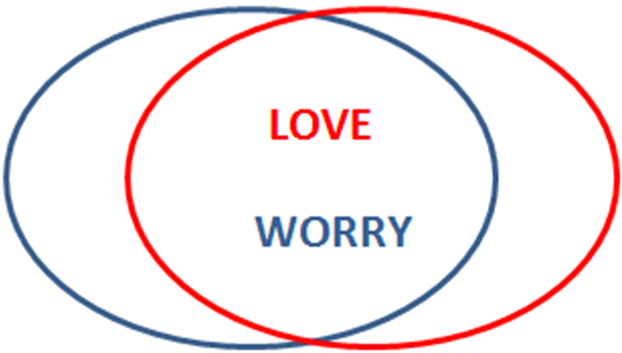A Coaching Power Tool created by Trish Brooks
(Executive Coach, CANADA)
ICA Power Tools present two opposing perspectives to the client so that underlying beliefs/behaviours can be explored and the potential for change is opened up.
The Power Tool that will be discussed here is “Collapsed Distinctions”. A collapsed distinction occurs when a person is not distinguishing between two emotions/beliefs/concepts. The collapse of the two emotions/belief/concepts is often a barrier to moving the client forward. By pulling apart the two ideas, and exploring the two different perspectives, awareness is created, and new opportunities can emerge. Examples will make the concept clearer.
Collapsed Distinction #1: Love and Worry
A frequently occurring collapsed distinction is ‘love’ and ‘worry’. The worry referred to here could be labelled “parental worry”. Here is an excerpt from a coaching conversation that shows the collapse of the distinction between love and worry.
Coach: What makes you so worried?
Client: If I worry about him then that shows how much I love him. It shows I’m concerned about his welfare.
Coach: Can you love him without worrying about him?
Client: Wouldn’t that mean I didn’t love him? Worry proves I care.
The collapse of the distinction between ‘love’ and ‘worry’ is evident in the discussion above. Instead of being two independent emotions, their spaces overlap significantly (Figure 1). The person believes that worry is a necessary part of love.
If the coach is supporting the client to worry less, without separating the collapsed distinction, then it would like saying “love less”, and the client would have difficulty moving forward. The distinction between love and worry must be discovered before the client can move forward to a state of less worrying.
Let’s examine the two perspectives underlying the collapsed distinction in more detail.
Perspective (1): Worry is a necessary component of love (collapsed distinction).
There is a strong cultural bias in North American culture that worrying about children goes hand in hand with loving them. But in truth, parental love is far more powerful without worry than with it.
Sometimes worry is seen as a form of struggle, and the more the more a person suffers and struggles, the more that demonstrates love. “Can’t you see how much I’m suffering?” is synonymous for “Can’t you see how much I love you?”
Does worrying really make the child safer? In fact it doesn’t. Worry focuses energy on what you don’t want rather than on what you do want. Does worry teach your child something important and useful? The message to the child is that you expect bad things to happen, and it puts the child in a state of fear. And the statistics indicate that the worry is often not based on reality. For example, parents often worry about abduction (odds are 1 in 200,000) but have much less fear driving about their child around in a car (odds of death in a car crash are 1 in 8000)[1]. As Mark Twain said “I lived a life of many terrible things, most of which never happened”.
If this perspective is analyzed it becomes quickly apparent that worry cannot possibly help anything. Worry and fear close the heart. They limit the ability to experience life fully. “Worry never robs tomorrow of its sorrow, it only saps today of its joy.” (Leo Buscaglia). Worrying may even lead to a self-fulfilling prophecy.
Perspective (2:) Love without worry (no collapse).
The more powerful perspective is that a person can love someone without having to worry. This perspective separates the distinction between love and worry (Figure 2). The parent can still be vigilant, and take reasonable precautions to ensure safety. However, this vigilance can be done with a relaxed energy of “this makes sense to do”. The focus is shifted to what is desired (e.g., a safe car ride), rather than on what is not wanted (e.g., a car crash). Before long a more hopeful, optimistic energy can emerge, and the heart can open more fully. That has much more benefit to the child.
Collapsed Distinction #2: Understanding and Agreement
It is not only emotions that can be collapsed. Behaviours can also be collapsed. For example, a behavioural collapsed distinction that frequently occurs is ‘understanding’ and ‘agreement’. You can understand someone without agreeing with them. If the coach is supporting the client to be more understanding without separating the collapsed distinction, then it would like saying “agree more” and the client would have difficulty moving forward. The distinction between love and worry must be discovered before the client can move forward to a state of increased understanding.
Let’s explore the two perspectives in more detail.
Perspective (1): Understanding someone means I agree with them (collapsed distinction).
The behaviors of understanding are seen similar to those for agreeing. “If I ask them questions about their idea, they’ll think that I agree with them”. If this is believed a person may not get curious about the ideas of others; they might not ask questions; they might not listen effectively. They may miss the solutions that others have for their problems. In fact you can listen effectively to someone, and ask lots of questions, and that does not mean you agree with them. Agreement and understanding are two distinct concepts.


